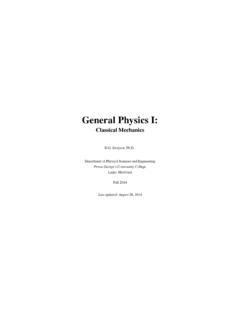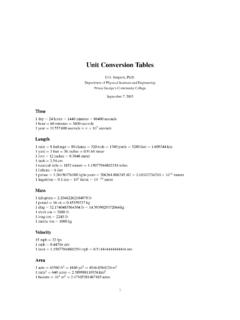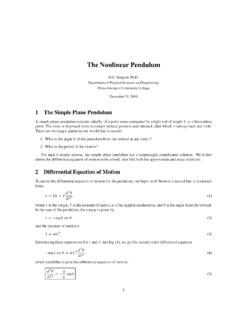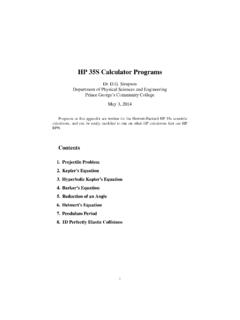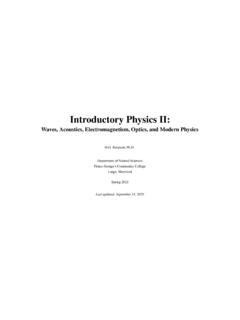Transcription of Gauss’s Law for Gravity - pgccphy.net
1 gauss s Law for Simpson, of Physical Sciences and EngineeringPrince george s Community CollegeDecember 6, 2006 Newton s Law of GravityNewton s law of Gravity gives the forceFbetween two point massesMandm, separated by a distancer:FDGMmr2;(1)whereGis the universal gravitational constant,6:67428 10 11m3kg 1s 2. By Newton s second law,force is related to acceleration byFDma:(2)Equating equations (1) and (2), we can solve for the accelerationadue to the Gravity of a point charge:aDgDGMr2:(3)Newton was able to show that the gravitational field due to a uniform sphere of mass is the same as if thesphere were a point mass located at the sphere s center of mass. (Newton invented the calculus in the process!)So, for example, we can use Equation (3) to find the acceleration due to Gravity at the surface of the sphericalEarth:gDGMeR2e;(4)whereMeis the mass of the Earth, andReis the radius of the Earth.
2 Substituting the known values ofGMeandRe, we findgD3:986005 1014m3s :378140 106m/2D9:80m s 2;(5)which is the familiar Gaussian Formulation of Newtonian GravityAn alternative formulation of Newtonian Gravity is gauss s Law for Gravity . It states that the accelerationgdue to Gravity of a massm(not necessarily a point mass) is given byISg ndAD 4 Gm(6)1 This equation requires a bit of explanation. The circled integral sign indicates an area integral evaluatedover aclosedsurfaceS. A closed surface may be a sphere, cube, cylinder, or some irregular shape anyclosed surface that has a well-defined inside and outside. The integral is an area integral: we imagine thatthe surfaceSis divided into many infinitesimal squares, each of which has areadA.
3 Performing the integralmeans summing up the integrand timesdAover the entire closed vectorgis the acceleration due to Gravity , as avector. The vector always pointstowardthe vectornis aunit vector, perpendicular ( normal ) to the surfaceS, and the right-hand side of Equation (6), we find familiar constants ( andG), along with massm. Heremis the total massinsidesurface S. It doesn t matter what shape the massmis, or how it is distributed;misjust the total mass inside gauss s law for Gravity says this: we re given some massm, which may be of some arbitrary imagine constructing animaginarysurfaceSaround massm(a sphere, or any other closed shape).Divide surfaceSinto many infinitesimally small squares, each of which has areadA.
4 At each square, drawa unit normal vectornthat is perpendicular to the surface at that square s location, and which is pointingoutward fromS. Letgbe the acceleration due to Gravity at that square. If we take the dot product ofgandnat that square, multiply by the area of the squaredA, then sum up all of those products for all the squaresmaking up surfaceS, then the result will be 4 Gtimes the total mass enclosed law applies in general, but in practice it is most useful for finding the acceleration to to gravitygdueto a highly symmetrical mass distribution (a point, sphere, line, cylinder, or plane of mass). In these cases,the integral is particularly easy to evaluate, and we can easily solve forgin just a few MassFor example, let s use gauss s law to find the accelerationgdue to the Gravity of apointmassm.
5 (The resultshould be Eq. 3.) We begin with a point massmsitting in space. We now need to construct an imaginaryclosed surfaceSsurroundingm. While in theory any surface would do, we should pick a surface that willmake the integral easy to evaluate. Such a surface should have these properties:1. The gravitational accelerationgshould be either perpendicular or parallel The gravitational accelerationgshould have the same value everywhere onS. (Or it may be zero onsome parts ofS.)3. The surfaceSshould pass through the point at which you wish to calculate the acceleration due we can find a surfaceSthat has these properties, the integral will be very simple to evaluate. For thepoint mass, we will chooseSto be asphereof radiusrcentered on massm.
6 Since we knowgpoints radiallyinward toward massm, it is clear thatgwill be perpendicular toSeverywhere. Also, by symmetry, it is nothard to see thatgwill have the same value everywhere chosen a surfaceS, let us now apply gauss s law for Gravity . The law states thatISg ndAD 4 Gm:(7)Now everywhere on the sphereS,g nD g(sincegandnare anti-parallel gpoints inward, andnpointsoutward). Since gis a constant, Eq. (7) becomes gISdAD 4 Gm:(8)2 Now the integral is very simple: it is justdAintegrated over the surface of a sphere, so it s just the area of asphere:ISdAD4 r2:(9)Equation (8) is then just r2/D 4 Gm;(10)or (cancelling 4 on both sides)gDGmr2(11)in agreement with Eq. (3) from Newton s of MassThe Gaussian formulation allows you to easily calculate the gravitational field due to a few other example, suppose you have an infinitely longlineof mass, having linear mass density (kilograms permeter), and you wish to calculate the accelerationgdue to the Gravity of the line mass at a perpendiculardistancerof the mass.
7 The appropriate imaginary Gaussian surface Sin this case is a cylinder of lengthLand radiusr, whose axis lies along the line mass. In this case, everywhere along the curved surface of cylinderS, the gravitational accelerationg(pointing radially inward) is anti-parallel to the outward normal unit vectorn. Everywhere along the flat ends of the cylinderS, the gravitational accelerationgisperpendicularto theoutward normal vectorn, so that on the ends,g nD0, and the ends contribute nothing to the integral. Wetherefore need only consider the curved surface of apply gauss s law:ISg ndAD 4 Gm:(12)Sincegis anti-parallel tonalong the curved surface of cylinderS, we haveg nD gthere. Bringing thisconstant outside the integral, we get gISdAD 4 Gm:(13)The integral is just the area of a cylinder:ISdAD2 rL;(14)so Eq.
8 (13) becomes rL/D 4 Gm:(15)Nowmis the total mass enclosed by surfaceS. This is a segment of lengthLand density , so it has mass L. This gives rL/D 4 G. L/:(16)Cancelling 2 Lon both sides givesgD2G r(17)3 Plane of MassIn addition to spherical and cylindrical symmetry, this technique may also be applied to plane that you have an infiniteplaneof mass, having area mass density (kilograms per square meter),and you wish to calculate the accelerationgdue to the Gravity of the plane at a perpendicular distancerfromthe plane. The approach is similar to the previous cases: draw an imaginary closed Gaussian surface, writedown gauss s law for Gravity , evaluate the integral, and solve for the this case, the appropriate Gaussian surfaceSis a pillbox shape a short cylinder whose flat faces(of areaA) are parallel to the plane of mass.
9 In this case, everywhere along the curved surface ofS, thegravitational accelerationgisperpendicularto the outward normal unit vectorn, so the curved sides ofScontribute nothing to the integral. Only the flat ends of the pillbox-shaped surfaceScontribute to the each end,gis anti-parallel ton, sog nD gon the apply gauss s law to this situation:ISg ndAD 4 Gm:(18)Here the integral needs only to be evaluated over the two flat ends ofS. Sinceg nD g, we can bring goutside the integral to get gISdAD 4 Gm:(19)The integral in this case is just the area of the two ends of the cylinder,2A(one circle of areaAfrom eachend). This gives 4 Gm:(20)Now let s look at the right-hand side of this equation. The massmis the total amount of mass enclosed bysurfaceS.
10 SurfaceSis sort of a cookie cutter that punches a circle of areaAout of the plane. The massenclosed bySis a circle of areaAand density , so it has mass A. Then Eq. (20) becomes 4 G. A/(21)Cancelling 2 Aon both sides, we getgD2 G (22)Note that this is a constant: the acceleration due to Gravity of an infinite plane of mass is independent of thedistance from the plane!In his science fiction novel2010: Odyssey Two, author Arthur C. Clarke describes a large rectangular slabthat has been build by an alien race and placed in orbit around Jupiter. Astronauts are able to calculate themass of the slab by placing a small spacecraft near the center of the large face and timing it to see how longit takes to fall to the surface of the slab.
